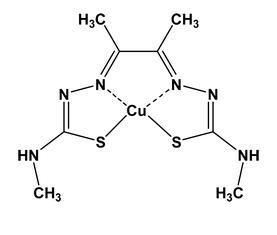In August 2016, Collaborative Medicinal Development launched a phase 1 pharmacokinetic and dose escalation study into the tolerability of copper-containing small molecule drug, known as Cu(II)ATSM, in people living with ALS. CuATSM has been shown in laboratory-based studies to deliver copper to cells in the spinal cord to help prevent misfolding of the SOD1 protein, which is associated with some forms of familial ALS. Efficacy of this treatment has been extensively tested in the SOD1 model of ALS at the University of Melbourne and the University of Oregon. Scientists at the ALS Therapy Development Institute also published findings showing independent validation of the efficacy of CuATSM at slowing down disease progression in a mouse model of ALS.
Earlier this year, the sponsoring company launched an extension study which is open to those the investigators think may benefit from continued  treatment following successful completion of the entire phase 1 study. This extension study is designed to gather robust data both on potential side effects of long-term exposure to the copper based treatment, as well as additional data on disease progression. At this time, the original study, is still open for enrollment at Macquarie University, Australia and Calvary Health Care Bethlehem, Australia. The phase 1 study aims to recruit 50 people living with ALS. Enrollment in the phase 1 study is open to those living with ALS who are between the ages of 18 and 75 years with a forced vital capacity of greater than or equal to 70% of predicted value for age, height and gender at the time of screening. Those experiencing symptoms for more than 24 months or those using mechanical ventilation are not eligible for this trial.
treatment following successful completion of the entire phase 1 study. This extension study is designed to gather robust data both on potential side effects of long-term exposure to the copper based treatment, as well as additional data on disease progression. At this time, the original study, is still open for enrollment at Macquarie University, Australia and Calvary Health Care Bethlehem, Australia. The phase 1 study aims to recruit 50 people living with ALS. Enrollment in the phase 1 study is open to those living with ALS who are between the ages of 18 and 75 years with a forced vital capacity of greater than or equal to 70% of predicted value for age, height and gender at the time of screening. Those experiencing symptoms for more than 24 months or those using mechanical ventilation are not eligible for this trial.
Treatment is administered orally and the phase 1, open label trial is split into three phases. During the first phase, participants will be divided into 5 dose cohorts and will receive one of the following doses; 3, 6, 12, 24, or 48 mg of the drug in a day. Biosamples will be collected 5 times throughout the first day of dosing to measure changes in plasma concentrations of the drug overtime. The second phase consists of the same dosing per day for each cohort over the course of 28 days. Throughout this 28 day period, safety is assessed to determine the recommended phase 2 dose (“RP2D”). Finally in the third phase, participants are given the RP2D for up to six 28-day treatment cycles to assess tolerability and initial signs of efficacy.
Continued treatment in the extension study will go on until one of the following three things happens: 1. The investigator no longer deems the treatment beneficial to the participant, 2. The patient becomes dependent on mechanical ventilation, i.e. they are unable to lie flat or sleep without it or if they use it throughout the day, or 3. The participant withdraws.
For a full description of these trials, including all exclusion criteria and contact information, click here for the initial study and here for the extension trial. Updates on site enrollment status and other changes to the study are monitored by ALS TDI and sent monthly via email to those subscribed to the clinical trial mailing list.
Useful links
Phase 1 Clinical Trial Design
Extension Study Design
ALS TDI Announces Independent Validation of Cu(II)ATSM
Sponsor’s Website